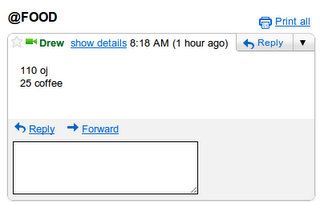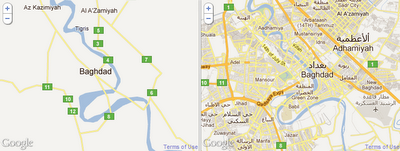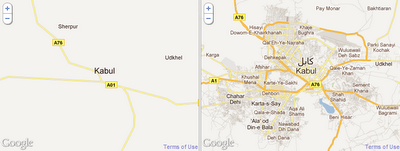It’s in the news lately that by 2030, 50% of the population will be obese. Well, I’m a bit (ok, maybe more than a bit) overweight now and was looking to do something about it. So for my diet, I’ve started counting calories. I’ve tried a number of other diets with mixed results, but calorie counting for me always works. However, counting calories can be a bit of a pain. There are a number of ways to figure out how many calories are in things, such as the container the item comes from, websites like http://caloriecount.about.com/, http://fatsecret.com/ or search on your favorite search engine. Finding out the calorie content of a food isn’t really so much of a problem in and of itself because after awhile you just know how many calories are in the usual things you eat. But where is the best place to keep track the current running total for the day? It has to be easily accessible to me or I don’t do it. I don’t always have paper, nor am I in places where I have connectivity. Android, Gmail and of course, Google Apps Script to the rescue!
Counting Calories using Apps Script
The process is simple. I send an email to myself with the subject “@FOOD” where the body contains the number of calories in the food and the name of the food, one per line. I wrote a script which, every 15 minutes, scans my email and computes the total of calories I’ve consumed in the last 24 hours and updates a spreadsheet with the total.
Why do it this way? Using Gmail for the recording makes it so if I’m offline on my phone, the gmail app will send it when I’m online. Putting it in a Google spreadsheet means I can make a shortcut for it in chrome, and a desktop web shortcut icon on my Android phone for easy access. Additionally, using a spreadsheet allows me to perform other calculations, make charts, etc.
How do you set it up?
First create a new spreadsheet, and click on Tools > Script Editor. Click on File > New > From Script Template. Search for “Calorie Counting” and you will be able to locate the script. Then, click Install and you are all set. Save the script, run it, at which point you’ll get two authorization dialogs, click ok through them. Run it again to make sure it populates the sheet properly. Then, in the script editor, click Triggers>Current script’s triggers and add a new trigger:
And you’re all set! Your spreadsheet, after the script runs will look like this:
From here the possibilities are endless. I’m thinking I could make a UiApp script which uses the new Charts bean to draw a graph. Perhaps make a service to view/change calories because I mess things up every once in awhile. You could also add code for “@WEIGH” messages to track weight and could graph that too. Your imagination is the limit! And if you have an even better idea for how to use Apps Script to improve Gmail and Spreadsheets, you can post it to our Gallery (Script Editor > Share > Publish Project) to share with the world.





